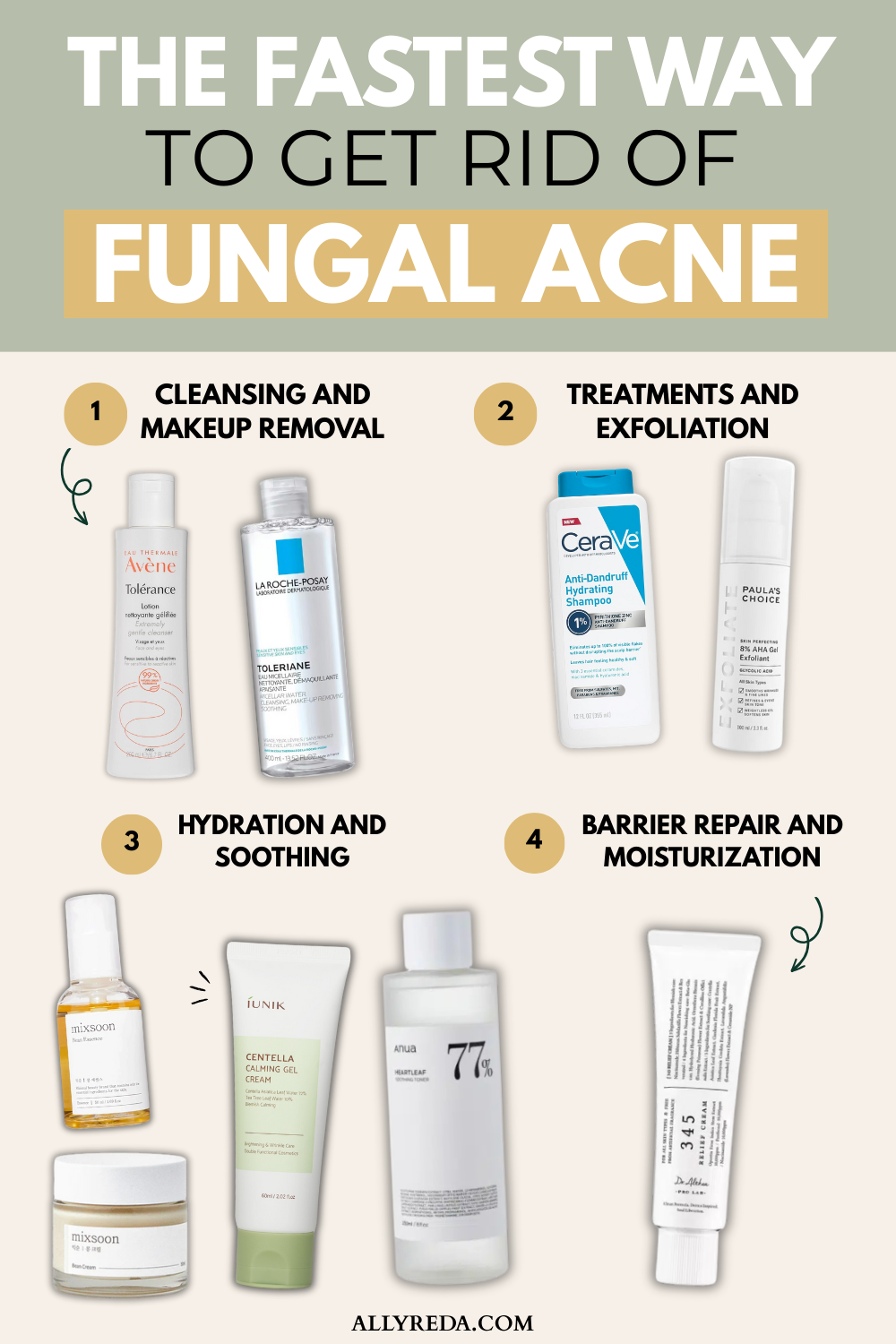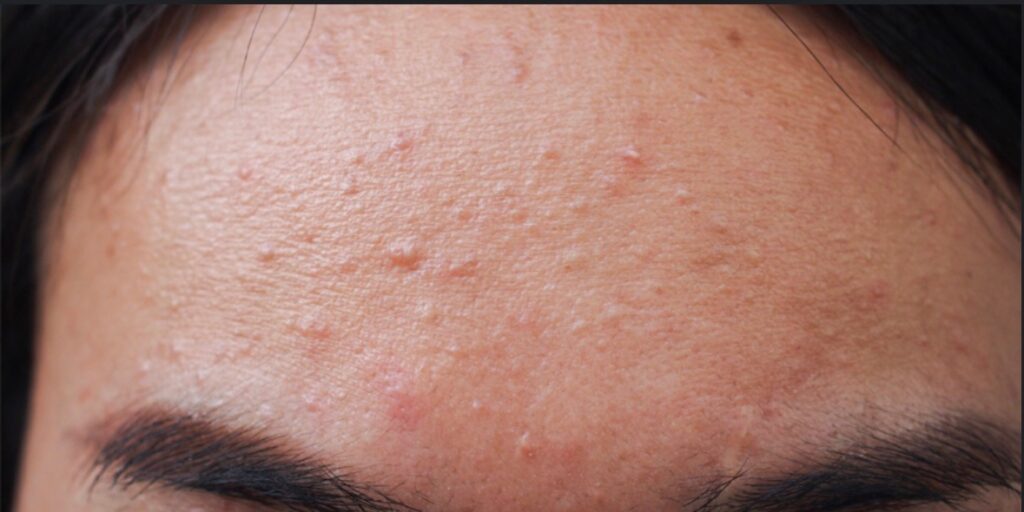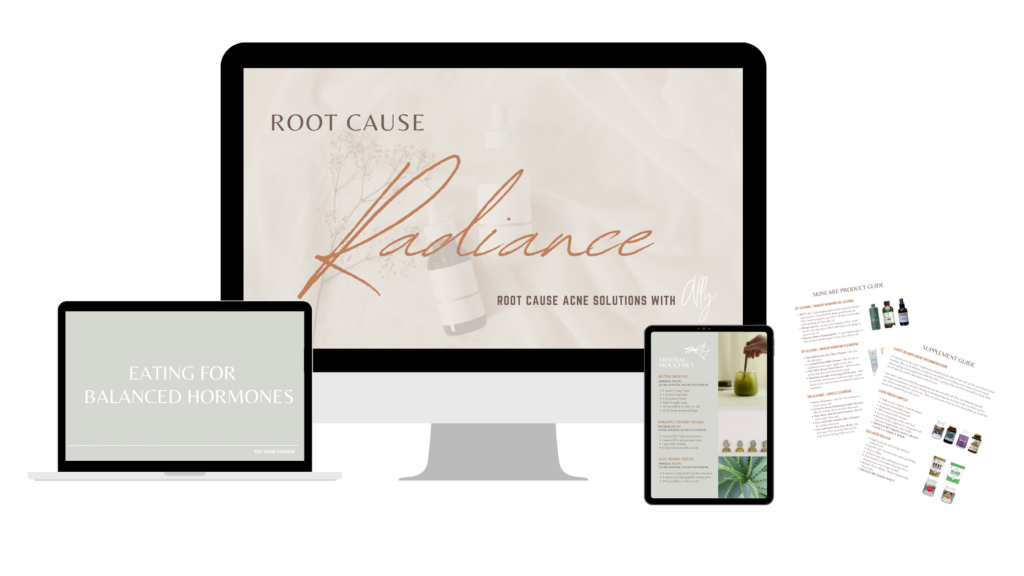The Blog
The Fastest Way to Get Rid Of Fungal Acne

If you’re fighting fungal acne—one of the 5 types of Acne—and feeling overwhelmed by product after product that doesn’t seem to work, you’re definitely in the right place. I know how frustrating it can be when it feels like nothing is helping. But trust me—you’re about to learn a surprisingly simple trick that can help clear up fungal acne fast and set you on the path to lasting, healthy skin.
Before we dive in, it’s important to understand that fungal acne is caused by an overgrowth of yeast, which means traditional acne treatments might not only be ineffective—they can sometimes make things worse. Stick with me as I walk you through my product recommendations and outline a tailored morning and evening skincare routine designed specifically for fungal acne.

What Is Fungal Acne (and Why Is It So Annoying)?
Fungal acne happens when yeast (Malassezia) takes over your skin, causing itchy, uniform bumps that often cluster on the forehead, chest, and back. Unlike regular acne, it’s not about clogged pores or bacteria. It thrives in warm, humid environments and can be triggered by sweaty workouts, oily products, and even antibiotics.
The trick to getting rid of fungal acne? Starve the yeast by controlling oil production and using targeted antifungal treatments. If you’re looking for gentle ways to support your skin while tackling fungal acne, check out 3 natural acne remedies—they can help soothe irritation and keep your skin balanced.
Tired of Guessing What’s Causing Your Breakouts?
Root Cause Radiance Can Help You Get Clarity (and Clear Skin)
Fungal acne isn’t just a surface issue—it’s often a sign that something deeper (like your gut or immune system) is out of balance. Inside Root Cause Radiance, you’ll learn how to restore your skin by working from the inside out using our proven 4-pillar method: gut + immune support, nourishment, detox, and barrier repair. No fluff. No endless trial-and-error. Just real guidance that works.

Best Products for Fungal Acne
- A Gentle Cleanser – Avene Tolerance Lotion
A gentle cleanser formulated to control yeast overgrowth while cleansing without stripping your skin. - Treatment – CeraVe Dandruff Shampoo
An antifungal shampoo that doubles as a treatment to reduce yeast overgrowth on the skin. - Exfoliating Acid Toner/Serum–Paula’s Choice 8% AHA Gel Exfoliant
A mild formulation with AHAs or BHAs that unclogs pores and removes dead skin cells without aggravating fungal acne. Best for oily and fungal acne-prone skin, this gentle exfoliant unclogs pores and smooths skin texture. - Makeup Remover – Micellar Water from La Roche-Posay
Effectively removes makeup, dirt, and impurities without disrupting your skin’s balance. - Hydrating Cream – Mixsoon Bean Cream
A nourishing, lightweight cream that hydrates without clogging pores—perfect for fungal acne. - Toner – Anua Heartleaf Soothing Toner
A calming, anti-inflammatory toner that hydrates and soothes irritated skin. - Essence – Mixsoon Bean Essence
A hydrating essence packed with nutrients to support a healthy skin barrier. - Calming Gel Cream – Iunik Centella Calming Gel Cream
Soothes redness and irritation while providing light hydration for acne-prone skin. - Barrier Repair Moisturizer – Doctor Althea 3 4 5 Cream
A hydrating moisturizer enriched with ceramides to rebuild and protect your skin’s natural barrier, ensuring it stays calm and resilient.
You definitely don’t need all 9 of these products—I just wanted to give you some fungal-safe options to choose from. I’ll break down a simple routine for you below!
Your Daily Skincare Routine
Morning Routine
- Step 1: Cleanse
Start your day by gently cleansing your face with the Anti-Fungal Cleanser to remove any overnight buildup while keeping fungal acne at bay. Or skip if your skin feels good. - Step 2: Tone/Hydrate
Use a calming anti-inflammatory toner, hydrating serum or essense that hydrates and soothes irritated skin. - Step 3: Moisturize
Apply the Barrier Repair Moisturizer to lock in hydration and reinforce your skin’s natural defenses. - Step 4: Protect
Finish with a mineral based sunscreen to shield your skin from UV damage—this step is essential in every routine.
Evening Routine
- Step 1: Remove Makeup
Use a Micellar Water to safely remove makeup without irritating fungal acne. - Step 2: Cleanse
Cleanse your face with a Gentle Cleanser to wash away the day’s impurities as well as remove all the micellar water without over-drying your skin. - Step 2: Treat
Apply a treatment like CeraVe Dandruff Shampoo areas where fungal acne is most pronounced (doesn’t need to be all over). Let sit for 5-10 mins. This helps calm inflammation and target the problematic spots. - Step 3: Tone/Hydrate
Use a calming, anti-inflammatory toner that hydrates and soothes irritated skin. - Step 4: Moisturize
Replenish your skin with the Barrier Repair Moisturizer to ensure it stays hydrated and continues to recover overnight. - Optional Step:
If your skin tolerates additional actives, consider incorporating the Exfoliating Acid Toner/Serum a few nights a week for a deeper cleanse. Just be sure to listen to your skin and adjust the frequency as needed. If you choose to use an exfoliating acid it you would do it as the second step after cleansing.
Is Something Bigger Going On?
If you’re still battling fungal acne despite trying targeted products and routines, it might be a sign that something deeper is going on internally. Fungal acne isn’t just a surface issue—it’s often a reflection of internal imbalances that need real attention. Getting to the root cause is essential for long-term, lasting results.
That’s why I created Root Cause Radiance, my online course designed to help you uncover and heal those underlying issues. If you’re ready to take a holistic approach to clear, radiant skin and address the real reasons behind your fungal acne, check out Root Cause Radiance. Let’s tackle this together—because you deserve skin that not only looks great, but feels healthy from the inside out.
Rooting for you always,
Ally
Be the first to comment